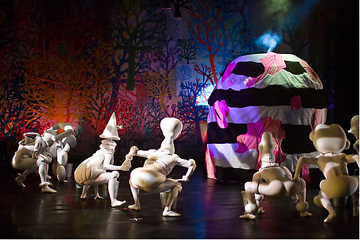What do you get when you mix religious overtones, memories of a few former vegan college roommates, comic book-inspired heroes and elegant ballerinas prancing around the stage in funny costumes? In the case of the collaboration between Houston-based contemporary artist Trenton Doyle Hancock (Season 2) and Ballet Austin, I would say a lot of conflicting clichés: archetypal values with a bit of a focus on flesh, eggs, and orifices.
It’s clear that absurdity plays a role in the mechanics of what makes this wondrously colorful ballet tick. Alas, culture and context are what enable us to investigate eye candy on a level we can mull in our minds and chew on with our souls. How fun and exciting—it sounds like a performance to really get the heart racing! (Beckett, are you there?)
For a description of the ballet performed this past spring, see this month’s issue of Art in America and specifically “Food for Thought,” Eleanor Heartney’s review of Cult of Color: Call to Color, a collaboration between Trenton Doyle Hancock, composer Graham Reynolds, and the Austin Ballet director Stephen Mills.
Heartney’s article examines many themes that course through the ballet. She states, “Thematically, the ballet lends itself to various interpretations. On one hand, it can be read as a repudiation of asceticism in favor of optical beauty, and as an affirmation of art as a realm of freedom. On the other, the battle of the ‘good’ with Vegans, who convert, and the ‘bad’ black ones, who resist, has peculiar racial overtones that Hancock, who is African-American, must have been aware of.” Heartney goes on to say, “…however, the full spectrum of color as mediator and redemptive force might be read as a vindication of the ‘post-racial’ notion of hybridity so much in vogue in the moment.”
I can only speculate how might Trenton Doyle Hancock respond to that. Perhaps with the following quote from Susan Mansfield’s article “Son of a Preacher Man” (2007):
- “I think at first I fooled myself into thinking it was about race,” he says. “There was a bit of exoticism happening, because I was black in a predominantly white art world. People saw that first and that was always the first thing mentioned in the press. I would take racial stereotypes and treat them like a cartoonist, make fun of them, make them my own. But the conversation about race is so confined, I decided to leave these things by the wayside and focus on storytelling. The icons I use now are more universal. The Mounds represent to me a kind of stabability, being at peace, growing, and acceptance. The Vegans are the complete opposite. They are about pushing out everything that’s good from themselves because they don’t trust it. In essence they get smaller and smaller as human beings, become this pale imitation of humanity, like skeletons…”
In her review, Eleanor Heartney does not fail to mention, “Color aside, the ballet offers a political parable about deceit, power oppression, and liberation…the forces of repression and tyranny can never completely overcome.” Well, I am happy to say that this superhero hasn’t given up. This November 20th, I look forward to James Cohan Gallery’s presentation of Hancock’s fourth solo exhibition, which will include four major new paintings, a new set of prints, and elements from the Cult of Color ballet. So if you missed his lecture and installation this past spring at the ICA in Philadelphia, come check out Hancock newest work in New York this fall.





Pingback: The Digest. 09.03.08. On-the-road edition. at C-MONSTER.net
Pingback: New guest blogger: Erin Riley-Lopez | Art21 Blog
Pingback: Best of the Art21 Blog, 2008 edition | Art21 Blog